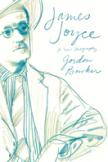Exile on O'Connell Street
In a fitting turnabout, this new biography gives James Joyce what he gave his characters in his great novel Ulysses: a sympathetic but unflinching portrait. In one day Ulysses goes from Leopold Bloom’s 8 a.m. thoughts in the outhouse to Molly Bloom’s 2 a.m. earthy memory-stream as husband and (unfaithful) wife lie in bed. Gordon Bowker’s James Joyce: A New Biography goes from Joyce’s Dublin birth in 1882 to his Zurich death in 1941, presenting (sympathetically) his genius, word-fun, sense of humor, transmuting imagination, prodigious knowledge and language-skills, family and many friends. It includes Joyce’s sympathy with Jews, passion for music and his love/scorn for Ireland and Dublin as well as (unflinchingly) his self-focus and arrogance, limp handshake, over-strong attraction to alcohol and women, fear of dogs and thunderstorms, publication problems, scorn of “the rabblement,” ever-failing eyesight and spendthrift inability to hold onto money.
Throughout, Bowker smoothly weaves together Joyce’s life and fiction, never hesitating to read the writer’s life in terms of his Joyce-like characters, or as Bowker puts it, “This biography will attempt to go beyond the mere facts and tap into Joyce’s elusive consciousness.” He recognizes that a writer puts part of himself into his novel and that novels can well be read as part of the author’s biography. Thus, James Joyce: A New Biography is at once a study of the man, his mind, his acts of writing and his work.
Bowker, an English biographer of Malcolm Lowry, George Orwell and Lawrence Durrell, nicely balances Joyce-in-life and Joyce-in-fiction as “Jim” wanders through life (with wife Nora and children Giorgio and Lucia) from Dublin to Paris to Dublin to Trieste to Rome to Trieste to Zurich to Trieste to London to Paris to Zurich and to many other cities and watering-places, as he works on Dubliners, Portrait of the Artist as a Young Man, Ulysses and Finnegans Wake, as well as poems, essays and his play “Exiles.” Ever haunted by the Dublin he loved but rejected—his “Dear Dirty Dublin”—Joyce makes its streets, pubs, houses, humans and environs live forever, indelibly, in his pages.
Bowker’s biography enjoys many felicities. His research is prodigious, his sources up to date and the abundance of detail wonderful and illuminating. Joyce, for example, once had a cat, used vulgar language, rejected psychoanalysis, sometimes cried at the beauty of words, was so apolitical that he saw World War II “only from a personal point of view,” spoke of his novel as “Oolissays” and loved to hear “Anna Livia Plurabelle” (a part of Finnegans Wake) read “in a pure Dublin accent.”
His champions and benefactors are ever-present: Sylvia Beach, Harriet Weaver, Margaret Anderson, Jane Heap, John Quinn, Ezra Pound, Ford Madox Ford and T. S. Eliot. Religion is significant: born a Catholic and educated in Jesuit schools, Joyce firmly left the church at 16, with art replacing faith. Yet he still admired Catholic rituals, was obsessed with dates “especially saints’ days” and in 1940 asked Samuel Beckett (of all people) to join him at the cathedral in Moulins for the esthetic experience of an Easter liturgy.
Ireland continued to haunt him. It was his land of birth and family and “the isle...full of voices,” but it offered no prospects for artists and intellectuals, and he “needed to escape the suffocating atmosphere of British Ireland and the paralysing grip of Irish Catholicism.” Later, when Ireland finally won independence, he even refused to obtain an Irish passport.
Bowker also offers insight into Joyce’s work as a modernist writer. In Ulysses Joyce took the stream-of-consciousness technique from a French novel by Edouard Dujardin (who took the technique from operatic arias) and “employed it to such brilliant effect with such subtle brilliance [that] he is often credited, wrongly, with having invented it.” In Ulysses Joyce switched styles—“third-person narrator, mock liturgy, stylistic pastiche, catechism, newspaper headlines and surreal drama”—to “offer a confusion of voices orchestrated around a series of powerful myths and recurrent motifs,” showing “a new and quite astonishing virtuosity.”
Joyce then passed from the stream-of-consciousness climax of Ulysses to “a long night’s excursion into unconsciousness” in Finnegans Wake, which, Joyce wrote, takes place in “the dream state.” Bowker continues, “the reader should just allow the language to have its effect” in this “form of a dream,” which is in “the form of a river” flowing out, then returning to its source and also a stream of unconsciousness and also a series of cabaret acts as “protean characters come and go, form and transform themselves.” For Joyce, “the words the reader will see [are] not those he will hear.” Is Finnegans Wake literature’s greatest puzzle?
Bowker stumbles, though, in his treatment of Catholicism. He misses the difference between “Jesuit” and ”Jesuitical,” mixes up “consubstantiation” and ”transubstantiation,” has the wrong Latin ending for the Jesuit motto “AMDG” (“Ad...gloria”), chooses the wrong verb in “Joyce attended his first communion” (it should be “made”) and uses prejudiced language about being Catholic: “old muddled beliefs,” “the crust of religious superstition.” But on balance, Bowker has written an excellent book.
Joyce “was a man of extremes,” Bowker concludes, and his last two paragraphs offer a brilliant summary of this “polymorphic” man and artist. For those who know and love Joyce’s work, Bowker’s James Joyce: A New Biography will be enticing and compelling, though it may be quite long, perhaps, for those who do not. I found it wonderful. Now I know Joyce.
This article also appeared in print, under the headline “Exile on O'Connell Street,” in the October 15, 2012, issue.








